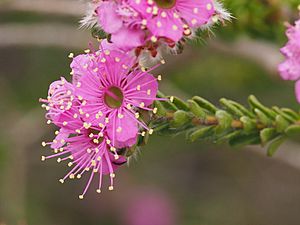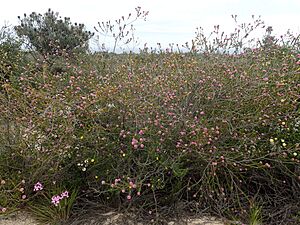Kunzea similis facts for kids
Quick facts for kids Kunzea similis |
|
|---|---|
 |
|
| Flowers and leaves of Kunzea similis | |
| Scientific classification | |
| Genus: |
Kunzea
|
| Species: |
similis
|
Kunzea similis is a type of flowering plant in the myrtle family, called Myrtaceae. It is found only in a small area along the south coast of Western Australia. This plant is a shrub with long, thin leaves that have just one vein. It grows pretty pink flowers in round groups of four to ten at the ends of its branches.

What it Looks Like
Kunzea similis is an upright shrub that usually grows between 0.5 m (1 ft 8 in) and 3 m (9.8 ft) tall. It has several main stems and not many branches. When the branches are young, they are covered with soft, silky hairs.
Its leaves are shaped like a line or a spear, with the narrower part near the base. They are about 4 mm (0.16 in) to 5 mm (0.20 in) long and 1.4 mm (0.055 in) to 2.8 mm (0.11 in) wide. Each leaf sits on a small stalk called a petiole, which is about 1.5 mm (0.059 in) long. A cool fact is that its leaves have only one main vein, which helps tell it apart from some other similar plants.
The flowers grow in round groups of four to ten at the tips of the shoots. At the base of the flowers, there are small, leaf-like parts called bracts and even smaller ones called bracteoles. The sepals, which are like small leaves that protect the flower bud, are triangular and covered in silky hairs.
The petals are pink and shaped a bit like a spoon. They are about 3 mm (0.12 in) to 3.5 mm (0.14 in) long. Each flower has many stamens (the parts that make pollen), usually between 32 and 44 of them, and they are about 5.6 mm (0.22 in) to 6.4 mm (0.25 in) long. This plant blooms from September to November. After flowering, it produces a fruit that looks like an urn, called a capsule.
Naming and Types
The plant Kunzea similis was officially named in 1996 by a scientist named Hellmut R. Toelken. Its name was published in a science journal called Journal of the Adelaide Botanic Garden. The second part of its name, similis, is a Latin word that means "like" or "similar."
In 2007, Toelken and another scientist, Gillian Craig, described two different types of this plant, called subspecies. These subspecies are recognized by the Australian Plant Census:
- Kunzea similis subsp. mediterranea: This type is a taller shrub, growing up to 3 m (9.8 ft) high. Its bracteoles (the small leaf-like parts near the flowers) are longer than those of the other subspecies.
- Kunzea similis subsp. similis: This type is a smaller shrub. Its bracteoles are usually hidden among the flowers.
Where it Grows
The subspecies similis is found in the Fitzgerald River National Park, close to Hopetoun. It grows in areas with low, scattered bushes, known as sparse heath.
The subspecies mediterranea lives in a small area east of Ravensthorpe. It grows on top of ridges in open mallee forests and thick heathland.
Keeping it Safe
Both subspecies of Kunzea similis are listed as "Threatened Flora" by the Department of Environment and Conservation (Western Australia). This means they are rare and need protection.
The subspecies similis is considered "critically endangered" under an Australian law called the Environment Protection and Biodiversity Conservation Act 1999. This means it is at very high risk of disappearing forever. The biggest danger to this plant is a fungal disease caused by something called Phytophthora cinnamomi. This disease can harm and kill many plants.

